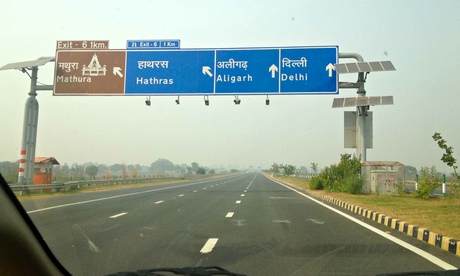
A few weeks ago, I decided to take my family from our home in Delhi to see the Taj Mahal, and asked Ajay, a Delhi chauffeur, which of the two routes he’d recommend – the old Grand Trunk Road or the new six-lane Yamuna Expressway.
Ajay warned me against the latter. “Too many fatalities,” he said, with a haunted expression. Another driver agreed: “Cars are always turning turtle.”
I’ve been in India long enough not to take advice about road conditions and distances at face value. Further probing revealed that neither driver had actually travelled on the route; they were merely repeating hearsay.
How, then, in a country that leads the world in road fatalities – more than a million have been killed in the past 10 years – could a motorway have earned such a fearsome reputation among drivers for whom Delhi’s anarchic traffic conditions are normal?
I set off on the Expressway across the Yamuna river and past the satellite city of Noida, with its gleaming call centres and apartment blocks. I was soon more baffled still. The $2bn expressway, which opened in 2012 and cut the driving time from Delhi to Agra by up to four hours, appeared as an alluring mirage: three pothole-free lanes in either direction, clearly marked and stretching off into the hazy distance. More surreal still: it was almost completely empty.
The usual lopsided Bedford trucks, bullock carts, auto rickshaws, slaloming hatchbacks and scooter swarms that infest every highway I have ever travelled on in India were conspicuous by their absence. There were no herds of goats forcing us to break abruptly, no mangled pye dogs, no villagers drying red chillies in the left-hand lane. We didn’t even encounter a single jugaad, a type of homemade vehicle with a lawn chair for a seat, coming straight at us in the wrong direction. There were also signs – large, legible signs – urging drivers to “Always Overtake On Right”. It hardly seemed possible we were still in India. And in a sense, we weren’t – at least not the India of the majority. Barbed-wire fencing along the 102-mile route ensures that the Expressway keeps India’s perennial maelstrom at bay, and the high tolls preserve the route for the wealthiest of drivers.
Soon, I was cruising at 80mph and congratulating myself on breaking the subcontinental land speed record – until a BMW went rocketing past.
Could this be the future of long-distance motoring in India? The government wants 11,500 miles of “controlled-access highway” to be built by 2022. The country’s main highways, which comprise 2% of India’s roads yet carry 40% of the traffic, are to be widened and improved as well. The only snag is that the National Highway Authority consistently delivers on less than half its annual target, and many road projects are running years behind schedule. Meanwhile, vehicle sales are growing exponentially – the figure just for November 2014 was 1,603,292, up more than 5% on October’s total.
It’s likely that the main highways will remain hopelessly congested, while new expressways go underused. Traffic volume on the Yamuna is two-thirds under capacity, according to the local development authority. On our two-hour drive, we passed (not to mention countless skid marks, some ending alarmingly at the foot of the divider) a dozen cars with flat or blown-out tyres – proof that Ajay’s fears were well-founded. Indian vehicles don’t have to pass any kind of test of roadworthiness – and nor do their tyres. Most are simply not up to travelling at a high constant speed. Clearly, along with new infrastructure, India needs an overhaul of its motoring culture.
Tarquin Hall’s latest novel is The Case of the Love Commandos (Arrow, £9.99). To buy a copy for £7.99 with free UK p&p, call 0330 333 6846 or visit bookshop.theguardian.com

